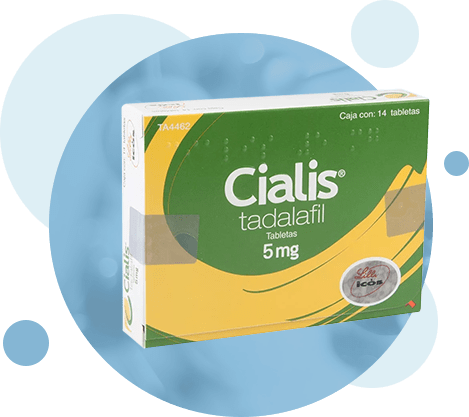
Pharmacy
Tadalafil reversibly selectively inhibits specific PDE5 cGMP and is a drug for the treatment of erectile dysfunction. With sexual arousal, nitric oxide is locally released, inhibition of PDE5 by tadalafil increases the content of cGMP in the cavernous body of the penis, which leads to relaxation of the smooth muscles of the arteries and blood flow to the tissues of the penis, an erection occurs. In the absence of sexual stimulation, tadalafil is ineffective. In in vitro studies, it was found that tadalafil is a selective inhibitor of PDE5 (an enzyme that is found in the smooth muscles of the corpus cavernosum, skeletal muscles, smooth muscles of the vessels of internal organs, platelets, lungs, kidneys, cerebellum). On PDE5, tadalafil acts thousands of times more active than on other phosphodiesterases (PDE1 - 4, 6 - 10, located in blood vessels, brain, heart, retina, liver and other organs). Tadalafil works for 36 hours. In the presence of sexual arousal, the effect of tadalafil appears within 16 minutes after ingestion. In healthy individuals, tadalafil does not cause significant changes in blood pressure, heart rate, color recognition, visual acuity, intraocular pressure, electroretinogram, pupil size, sperm characteristics. Carcinogenic, mutagenic properties and effects on fertility of tadalafil in animal studies have not been identified. When taken orally, tadalafil is rapidly absorbed. The maximum concentration of tadalafil is reached after about 2 hours. Food does not influence the degree and speed of absorption. The pharmacokinetics of tadalafil are linear in relation to dose and time. 94% of tadalafil binds to plasma proteins. With the participation of the isoenzyme CYP3A4, it is metabolized. The main metabolite is methylcatecholglucuronide, which is 13,000 times less active than tadalafil in relation to PDE5. The average oral clearance of tadalafil is 2.5 l / h, and the average elimination half-life is 17.5 hours. Tadalafil is excreted mainly in the form of inactive metabolites in the feces (about 61%) and urine (about 36%).

Indications
Erectile dysfunction therapy.
Contraindications
Hypersensitivity, joint administration of organic nitrates, concomitant therapy with alpha-blockers, age up to 18 years; not indicated for use in women.
Dosing
Tadalafil is taken orally, with or without food, at least 16 minutes before the expected sexual activity, the initial dose is 20 mg. Patients within 36 hours after taking tadalafil can attempt sexual intercourse in order to establish the optimal response time to taking the drug. The recommended maximum frequency of admission is 1 time per day. Elderly men do not need to adjust the dose of tadalafil. With mild and moderate hepatic impairment, the maximum dose of the drug is 10 mg once a day. In severe hepatic impairment, the use of tadalafil is not recommended, since there are no data on the safety of using tadalafil in such patients. With moderate renal failure (with creatinine clearance of 31-50 ml / min), the initial dose should not exceed 5 mg per day, the maximum dose should not exceed 10 mg every 48 hours. In severe renal failure in patients on hemodialysis, the maximum dose is not more than 5 mg per day. Patients taking CYP3A4 inhibitors, the maximum dose is 10 mg no more often than 1 time in 3 days.
Before using tadalafil, it is necessary to assess the patient's condition and collect anamnesis to identify the causes of erectile dysfunction and select adequate methods of therapy. The combination of tadalafil and other treatments for erectile dysfunction is not recommended. The patient should immediately consult a doctor if an erection occurs that lasts 4 hours or more. Late therapy for priapism leads to irreversible damage to the tissues of the penis. No cases of priapism have been reported with tadalafil. You need to know that sexual activity is potentially dangerous for patients who have diseases of the cardiovascular system.
Side effects
- Circulatory system: angina pectoris, hypotension, chest pains, hypertension, orthostatic hypotension, myocardial infarction, syncope, palpitations, tachycardia;
- Nervous system: fatigue, asthenia, dizziness, insomnia, hypesthesia, drowsiness, paresthesia, vertigo, headache;
- Digestive system: dyspepsia, diarrhea, changes in liver function tests, dry mouth, esophagitis, dysphagia, gastroesophageal reflux, increased levels of gamma-glutamyl transpeptidase, nausea, gastritis, vomiting, pain in the upper abdomen;
- Skin: facial swelling, hot flashes, sweating, rash, itching;
- Support and movement system: pain in the limbs, neck, back, myalgia, arthralgia;
- Respiratory system: nasal congestion, nosebleeds, dyspnea, pharyngitis;
- Organ of vision: changes in color vision, visual impairment, conjunctivitis, conjunctival hyperemia, increased tearing, eye pain, eyelid edema;
- Genitourinary system: spontaneous erection, increased erection
Interaction
Tadalafil is metabolized mainly with the participation of the cyp3a4 enzyme. ketoconazole, being a selective inhibitor of cyp3a4, increases the auc of tadalafil by 107%, and rifampicin, being an inducer of cyp3a4, reduces the auc of tadalafil by 88%. it can be assumed, despite the fact that specific interactions have not been studied, that cyp3a4 inhibitors such as itraconazole and erythromycin, as well as protease inhibitors such as saquinavir and ritonavir, increase the activity of tadalafil. tadalafil enhances the hypotensive effect of alpha-blockers and nitrates (co-administration is contraindicated). when antacids and tadalafil are taken together, the rate of absorption of tadalafil decreases without changing its auc.

Special instructions
Restrictions on use
- Myocardial infarction within the previous 3 months, stroke, suffered within the last 6 months
- Angina pectoris that occurs during intercourse
- Unstable angina pectoris, uncontrolled arrhythmias, uncontrolled arterial hypertension, arterial hypotension (with arterial pressure less than 90/50 mm Hg), heart failure (grade 2 and higher), which has developed within the last 6 months
- Severe liver failure, anatomical deformity of the penis (cavernous fibrosis, angular curvature, Peyronie's disease), predisposition to priapism (multiple myeloma, sickle cell anemia, leukemia), hereditary degenerative diseases of the retina (including retinitis pigmentosa)
Application during pregnancy and lactation
Tadalafil is not for use in women.
Overdose
In case of an overdose of tadalafil, an increase in adverse reactions is possible. When patients with erectile dysfunction were prescribed multiple doses of up to 1000 mg and single doses of up to 500 mg to healthy volunteers, the adverse events were the same as when using lower doses. Standard supportive treatment is required; hemodialysis is ineffective.
 DE
DE FR
FR IT
IT ES
ES








